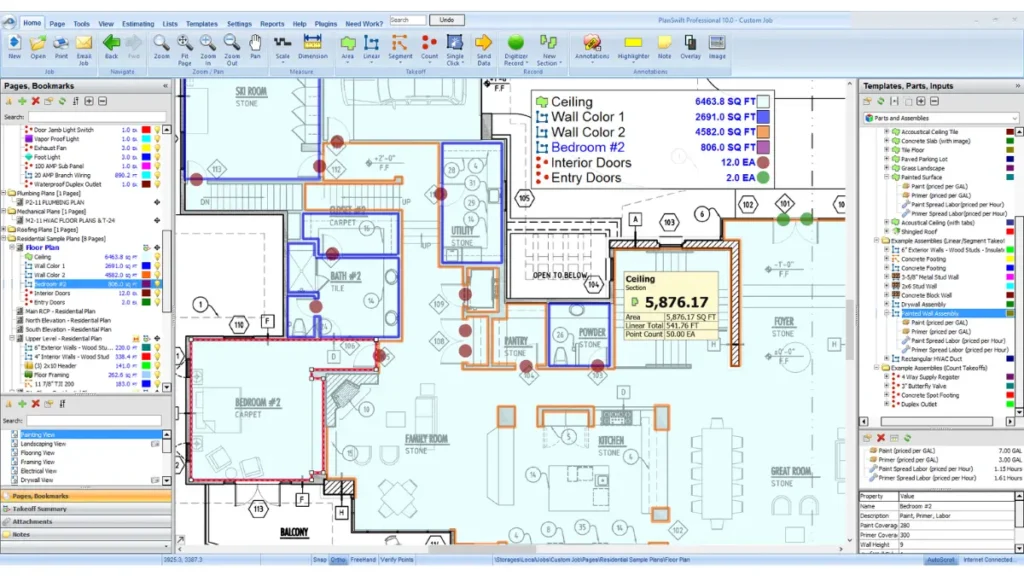
Introduction: Why Estimating Software Is a Game-Changer in 2025
In 2025, construction estimating software isn’t optional—it’s the backbone of competitive, profitable project delivery. Whether you’re a builder quoting home extensions, a surveyor preparing a Bill of Quantity, or a contractor managing multi-trade tenders, estimating tools are critical for pricing accuracy, coordination, and winning work.
The days of Excel-based estimates and paper takeoffs are ending. With inflation, labour shortages, and tight margins, digital tools offer the speed and clarity needed to stay ahead. Modern solutions align directly with our Cost Estimation Services and support efficient Quantity Takeoff Services across all project types.
Top Construction Estimating Software in 2025
Here are the leading platforms based on performance, user experience, integrations, and market adoption:
- CostX: A BIM-integrated tool widely used by quantity surveyors. Supports 2D/3D takeoffs, cost libraries, and client-ready reporting.
- Buildertrend: Popular with residential builders and remodelers. Includes estimating, scheduling, and client communications in one dashboard.
- ProEst: Cloud-based and powerful for commercial estimating. Strong database and subcontractor quote management features.
- Buildxact: Great for small to medium contractors. Includes takeoffs, quote templates, and purchase order tracking.
- Houzz Pro: Tailored for design-build firms and small builders. Combines quoting, CRM, and client invoicing.
Each tool serves a different niche. While ProEst suits larger GC firms, Buildxact and Houzz Pro work best for local builders quoting extensions, kitchens, and renovations.
Key Features to Look For in Estimating Programs
When choosing a construction estimating software, features matter more than brand name. Here’s what to prioritise:
- Quantity takeoff tools: Integrated digital takeoff saves time and reduces error vs manual measurement.
- Customisable cost databases: Ability to import supplier pricing or use market benchmarks.
- Estimate versioning: Track revisions, notes, and alternatives for client clarity.
- Client-ready output: Quote formatting tools that look professional and make prices transparent.
- Integration: Sync with scheduling, invoicing, or accounting platforms (Xero, QuickBooks, etc).
Contractors using outdated or standalone estimating tools often miss opportunities due to slow turnarounds and pricing gaps.
Free Construction Estimating Software in 2025
Not every company can invest in premium software. Fortunately, there are free or low-cost options ideal for solo builders and startups:
- Joist: Mobile-first estimating and invoicing app for small trades. Free basic plan.
- EasyEst: Windows-based estimating software with a free trial and flexible pricing tiers.
- Excel templates + plugins: While not ideal for scaling, free Excel-based systems can be enhanced with templates or plugins like Sigma.
These tools offer solid functionality but may lack automation or integration found in paid tools. Still, they’re a strong step up from handwritten or disorganised quotes.
Building Estimating Software for Surveyors
For quantity surveyors and cost consultants, precision and reporting flexibility are essential. Tools like CostX, Bluebeam Revu, and Cubit dominate here. These allow for:
- Detailed measurements linked to cost items
- Graphical markup of plans and takeoffs
- Export to bill of quantities (BoQ) formats or client summaries
Surveyors also appreciate integrations with BIM platforms and the ability to perform comparisons between actual costs and early estimates for project tracking.
Estimating Software for Builders and Contractors
Builders need speed, repeatable templates, and supplier linkages. Tools like Buildxact and Houzz Pro are designed for rapid quote generation. Key advantages include:
- Pre-loaded cost libraries with real-time updates
- Option to create and send quotes directly to clients
- Task lists and scheduling integration post-award
Contractor cost estimator tools also make it easier to manage supplier requests, compare subcontractor quotes, and deliver proposals that win work. Cloud access ensures you can price a job from your laptop, tablet, or phone—anytime, anywhere.
Trends in Construction Estimating Software (2025 Edition)
Software tools are rapidly evolving. In 2025, we’re seeing more automation, better AI integrations, and stronger visualisation tools. Here’s what’s trending:
- AI-based cost prediction: Software learns from past projects to recommend price ranges.
- Augmented takeoffs: Visual tools to overlay estimates on live site imagery or 3D models.
- Blockchain-backed change logs: Secure records of estimate changes and approvals.
The best estimating tools now help builders win jobs and track cost accuracy throughout the project—not just at tender stage.
How to Choose the Right Software for Your Business
Before you commit, consider your workflow. Do you need basic quotes or BoQ-level detail? Do you price multiple jobs a week or a few major ones per year? Are you working solo or with a team?
Also ask:
- Can the software scale with my business?
- Does it work on mobile and cloud?
- How easy is it to update cost data or integrate with suppliers?
Ultimately, the best construction estimating software is one that supports your pricing style, reporting needs, and client demands—without adding complexity.
Conclusion: Get Ahead With the Right Estimating Tool
In 2025, your estimating software is your business engine. It wins work, protects profit, and communicates value to your clients. Whether you’re pricing a loft conversion or managing a £5M tender, the right tool will save time, reduce errors, and increase success rates.
If you’re not sure where to start, try our free estimating or contact our team for help selecting the right platform for your workflow.